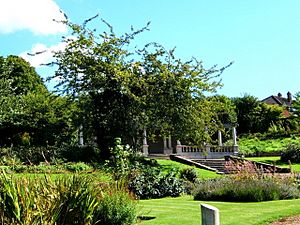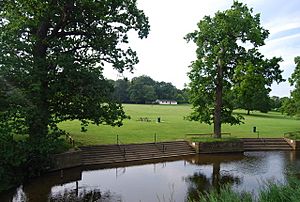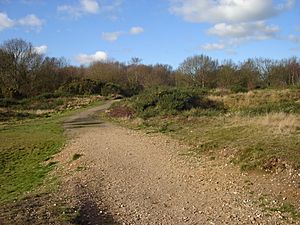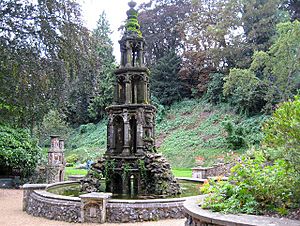List of parks, gardens and open spaces in Norwich facts for kids
The city of Norwich, England, has many amazing green spaces! In 2011, it had 23 parks, 95 open spaces, and 59 natural areas looked after by the local council. These places are perfect for playing, relaxing, and exploring nature.
Contents
Awesome Historic Parks in Norwich
Norwich has four really special historic parks. They were built in the 1920s and 1930s. A person named Captain Sandys-Winsch, who was the Parks Superintendent, designed them. His designs included cool buildings and structures made from a modern material called pre-cast concrete. Many unemployed men helped build these parks.
By the late 1990s, some of these structures were falling apart. Luckily, a group called the Heritage Lottery Fund gave money to fix them up. Now, these four main parks look great again!
- Heigham Park 52°37′34″N 1°16′03″E / 52.626°N 1.2676°E is in an area of the city called the Golden Triangle. It opened in 1924. You can find a children's playground, a bowling green, a playing field, and tennis courts here. There's also a small pond. Big beech trees, including some with copper-colored leaves, surround most of the park. You can also see pretty flower beds, bushes, and a concrete archway covered in wisteria flowers. This archway was part of the original design!
- Wensum Park 52°38′26″N 1°17′10″E / 52.6406°N 1.2862°E was finished in 1925. This park is right by the river. It has many old, tall trees, colorful flower beds, and a picnic area. There's also a children's playground and a paddling pool. Captain Sandys-Winsch's original concrete buildings are still there. For the city's millennium celebrations, a fun labyrinth was added in the middle of the park.
- Eaton Park 52°37′14″N 1°15′26″E / 52.6205°N 1.2571°E is a huge park, about 80 acres big. It's located west of the city center. This amazing park was opened by the Prince of Wales in 1928. Many of Captain Sandys-Winsch's original structures are still here. These include the round central building called a rotunda, a bandstand, a model boating pond, and a lily pond. The park also has lots of different sports facilities for you to enjoy.
- Waterloo Park 52°38′42″N 1°17′22″E / 52.6451°N 1.2894°E is north of the city center, between Angel Road and Aylsham Road. This park is about 18.5 acres. It opened in 1933 and has one of the biggest flower borders in a public park in the UK! Other cool things include a newly fixed paddling pool (from 2011), a children's playground, playing fields, tennis courts, and a bowling green. Many of the original buildings and designs are still there, like the pavilion and bandstand.
More Great Parks to Explore
Here are some other fantastic parks in Norwich. Many of them were also created in the 1920s and 1930s.
- Chapelfield Gardens 52°37′39″N 1°17′16″E / 52.6275°N 1.2878°E is right in the center of Norwich. When it opened in 1880, it was one of the only public green spaces downtown. The park is named after an old chapel. Today (in 2011), it has a restaurant, a bandstand, and a children's playground. You can also play pétanque or giant chess and draughts. The park hosts many events, like concerts, a yearly music festival, and funfairs. There are over 190 trees of 45 different types, plus many bushes and flower beds.
- Earlham Park 52°37′38″N 1°14′06″E / 52.6271°N 1.2349°E is about 3 miles west of the city center, next to Earlham Road. It's a huge open parkland, about 88 acres, that slopes down towards the River Yare. The local council bought this park in 1925. Part of it later became the home of the University of East Anglia. The park also has Earlham Hall, its old buildings, and pretty gardens. You can even rent the open park area for public events.
- Harford Park 52°36′20″N 1°17′02″E / 52.6055°N 1.2839°E is about 3 miles south of the city center, near Ipswich Road. It has a cool cycle speedway track, a bowling green, a five-a-side football pitch, and a children's play area. There's also the Harford Community Centre inside the park.
- Jubilee Park 52°36′50″N 1°17′53″E / 52.6138°N 1.298°E is in the Lakenham area, about 2 miles south of the city center. This park has an exciting adventure playground and a sports court with floodlights so you can play even when it's dark.
- Mile Cross Gardens 52°39′15″N 1°16′42″E / 52.6542°N 1.2783°E are two gardens that look exactly alike. They are at the corner of Suckling Avenue and Aylsham Road. These gardens are also "Grade II listed," meaning they are historically important. Captain Sandys-Winsch designed them, and they opened in May 1929. Today (in 2013), the south garden is a special area for wildlife. The northern garden is a children's playground.
- St Clements Park 52°39′07″N 1°17′49″E / 52.652°N 1.297°E is about 2 miles north of the city center, near Woodcock Road. It's an open grassy area with a small children's playground. In April 2011, this park became the city's first eco-park. This happened with money from the Big Lottery Fund and help from local schools and the community.
- Sewell Park52°38′44″N 1°17′52″E / 52.6455°N 1.2977°E is about 1.5 miles north of the city center, next to Constitution Hill. This park slopes down towards the south. It has a children's play area and old, tall trees. It also has a special connection to the family of Anna Sewell, who wrote the famous book Black Beauty.
- Sloughbottom Park 52°38′46″N 1°15′58″E / 52.6461°N 1.2661°E is about 3 miles north-west of the city center, near Drayton Road. This park officially opened in 1929. It was built to help people who didn't have jobs find work. It's a large, square park with several football pitches, a children's playground, and an all-weather sports court. Near the park's edge, you'll find the Sloughbottom Park BMX course, which is part of the National Cycle Route 1. The Sandys-Winsch pavilion, an interesting old building, is still used as a changing room for sports players.
Amazing Open Spaces and Nature Reserves
Norwich has many open spaces, including special local nature reserves and a Site of Special Scientific Interest. These are places where nature is protected.
Local Nature Reserves: Protecting Wildlife
- Bowthorpe Marsh 52°38′01″N 1°13′28″E / 52.6337°N 1.2245°E is in Bowthorpe, about 3.5 miles from the city center. It's a low-lying area of natural grassland with many drainage ditches. The site is next to the River Yare, and you can reach it by public footpaths. Horses graze here all year round.
- Danby Wood 52°36′12″N 1°16′35″E / 52.6033°N 1.2763°E is a natural broad-leaved woodland near Ipswich Road, about 2.5 miles south of the city center. This reserve is 3.4 hectares big and used to be a chalk quarry. Trees like oak, sycamore, ash, and lime have grown here. You can find beautiful snowdrops, arum lily, and bluebell flowers. Many different woodland birds also live here.
- Earlham Park Woods 52°37′29″N 1°13′53″E / 52.6246°N 1.2315°E is on the edge of Earlham Park. It's also known as Violet Grove and the Heronry. This reserve is 7.8 hectares and has many different types of habitats. These include thick marsh, natural grassland, woodland, and a pond that has been cleaned out to create open water.
- Eaton Common 52°35′57″N 1°15′36″E / 52.5991°N 1.2601°E is next to the River Yare in Eaton, about 4 miles south-west of the city center. It's 6.2 hectares of mostly natural grassland with some areas of tall plants and broad-leaved woodland. Cows graze here during the summer months.
- Lion Wood 52°37′46″N 1°19′22″E / 52.6294°N 1.3227°E is 9.2 hectares and about 1.5 miles east of the city center, near Thorpe Road. This wood was even mentioned in the old Domesday Book from 1086! It has many old, tall trees, especially sycamore and oak. Other trees include chestnut, beech, hornbeam, and birch. You can find bluebells and many woodland birds like jays and green woodpeckers here.
- Marston Marsh 52°36′10″N 1°16′09″E / 52.60291°N 1.26905°E is 26 hectares and about 3.5 miles south-west of the city center, near the A140 road. This reserve is a flood plain where cows graze, and it's surrounded by the River Yare. Many ditches cut through the site and are managed regularly. You can also find small areas of damp woodland and five ponds for wildlife. Beautiful marsh flowers, including orchids, have been seen here. Footpaths connect this reserve to Eaton Common and Danby Wood.
- Mousehold Heath 52°38′43″N 1°18′52″E / 52.6454°N 1.3145°E is the largest open space in the city, at 92 hectares. It's about 1.5 miles north-east of the city center and surrounded by several main roads. It used to be heathland, but now it's mostly broad-leaved woodland with a few small areas of heath still left. Interesting plants like heather, lizards, and woodland birds live here. There are also several sports pitches within the site.
- Wensum Local Nature Reserve 52°38′21″N 1°15′54″E / 52.6392°N 1.2649°E is about 2 miles north-west of the city center. It includes two areas: Sycamore Crescent Wood and Mile Cross Marsh. Both parts are connected by public footpaths. This reserve has many different habitats, including woodland, meadows, riverbanks, and marshes.
Site of Special Scientific Interest: A Very Important Place
- Sweetbriar Road Meadows 52°38′27″N 1°15′46″E / 52.6407°N 1.2628°E is a SSSI, which means "Site of Special Scientific Interest." It's a very important natural area, covering 23.55 acres. The site is about 3 miles west of the city center. It has a series of natural water-meadows that support many different kinds of plants and animals. This site is privately owned, so there's no public path through it, but you can view it from public paths around its edges.
Beautiful Gardens to Visit
Here are some lovely gardens in Norwich. Some are privately owned but open to the public sometimes to raise money for charity. Others are open regularly.
- The Bear Shop 52°37′56″N 1°17′49″E / 52.6321°N 1.2969°E is a small garden by the river. It's behind a 15th-century house (which is now a shop) in the Elm Hill area of Norwich. People think it might have been designed by a famous garden designer named Gertrude Jekyll. This garden is full of many different plants and has cool shaped bushes called topiary.
- The Bishop's House 52°37′59″N 1°18′10″E / 52.633°N 1.3027°E garden is inside the grounds of Norwich Cathedral. It's a large walled garden, about 4 acres, that dates back to the 12th century! It has many rare and unusual bushes and trees. Other features include rose beds, flower borders, a kitchen garden where food is grown, and a meadow labyrinth.
Listed below are gardens open regularly to the public.
- Grapes Hill Community Garden 52°37′54″N 1°17′04″E / 52.6317°N 1.2844°E is a small garden in the city center, close to the Norwich Inner Ring Road. It used to be an old, unused play area covered in tarmac. It officially opened in 2011. Volunteers take care of this garden. It has many plants you can eat, plus lots of wild and woodland flowers, grasses, bushes, and trees. There are also raised beds that people, including those in wheelchairs, can rent to grow their own vegetables.
- Plantation Garden 52°37′44″N 1°16′55″E / 52.6290°N 1.2819°E is a beautiful Victorian garden in the city center, next to St John the Baptist Cathedral. It's protected by old, tall trees. The garden is about 3 acres and has many original and restored features. These include a Gothic style fountain and an Italian-style terrace. You'll find lots of different seasonal flowers, bushes, and trees planted here.





